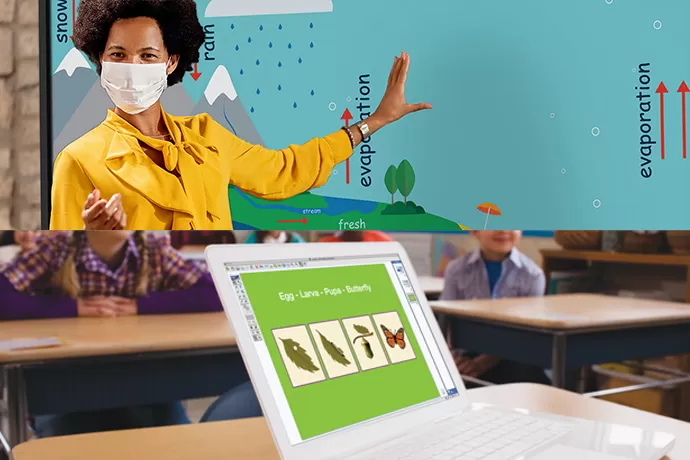Ethel Dwyer Middle School, Huntington Beach, California
Transforming a Historic Middle School Into a 21st Century Learning Space
How one California school used technology to empower its students and push past the “we just need to live through middle school” mindset that prevailed in its surrounding community.
Installation Snapshot
MimioStudio
Grades 6–8 • 1,300 students • 298 students qualify for free or reduced-price lunch
The Challenge
Situated in one of the lowest-funded school districts in California, Ethel Dwyer Middle School is a Huntington Beach icon. Built in the 1930s, the school’s principals were historically focused more on coaching teachers and encouraging success than on the actual teaching, learning, and staff management.
That changed when Christa Glembocki moved into the principal role a few years ago. “I wanted to set the stage for working as a team,” she says, “and being there for the betterment of our students.”
Glembocki also wanted to improve the school’s profile with the surrounding community, which didn’t look favorably upon the district’s two middle schools. “They loved the experience in our elementary schools, and they also loved the experience at the high school,” she explains. “However, the saying in the community was, ‘we just need to live through middle school.’”

A Change Is in the Air
When Glembocki joined Ethel Dwyer Middle School’s leadership team, some pockets of learning were very old school and traditional, such as rows of desks where students worked silently, answering questions from textbooks.
“The teacher called on one student at a time and everyone else just sat there,” says Glembocki. “Overall, the school wasn’t moving ahead with 21st-century learning, nor was it incorporating everything that we needed to with the P21 framework that we were working toward.”
Exposed to the Partnership for 21st-century Learning (P21)—a national nonprofit organization that advocates for 21st-century readiness for every student— in her previous positions, Glembocki knew that the system’s foundation was built on good teaching and learning fundamentals.
The challenge was that many of the school’s teachers were still centered on memorization and prepping for a test on Friday.
“21st-century learning isn’t about accessing and memorizing information; it’s about knowing how to apply that information through problem-solving and critical thinking,” says Glembocki. “That’s what our kids need in order to go out and get the jobs of today, and the jobs of tomorrow that we don’t even know exist.”
“21st-century learning isn’t about accessing and memorizing information; it’s about knowing how to apply that information through problem-solving and critical thinking.”
Christa Glembocki - Principal
Creating Modern Learning Spaces
When Huntington Beach City School District passed a bond that allowed it to redesign its learning spaces, Glembocki had a voice in what her school’s classrooms and learning spaces should look like. She wanted the spaces to incorporate built-in interactive technology along with furniture that gave students a choice in how they wanted to learn.
“It’s as simple as a student feeling more comfortable in a space all the way to let’s move the learning out of the classroom,” she says. For example, the school installed flexible seating in its hallways, where a group of students can get together and record a flip grid or a podcast. It also installed café-height tables where they can sit or stand while discussing lessons together.
In its classrooms, the middle school installed Boxlight interactive flat panel displays that teachers use to project classroom information, mirror student work, and allow students to write on. “Teachers are using the flat panels in many different innovative ways,” says Glembocki, “and students can pull up to them with a table, plug in their Chromebooks, and collaborate with one another.”
The displays also help reinforce positive behavior in the classroom, where the school’s “G.R.I.T.” positive behavior intervention support system awards students with “GRITcoin.”
Using the flat panel displays, students can independently check themselves in and out of the classroom without interrupting the class.
That’s What It’s All About
Looking ahead, Glembocki expects Ethel Dwyer Middle School’s commitment to creating 21st century learning environments supported by the P21 framework and advanced technology tools to gain momentum. “We’re building a culture where students and teachers feel like they’re part of a bigger community,” she says. “To me, that’s what it’s all about.”
.webp)
“We’re building a culture where students and teachers feel like they’re part of a bigger community.”
Christa Glembocki - Principal
Products used for this installation

